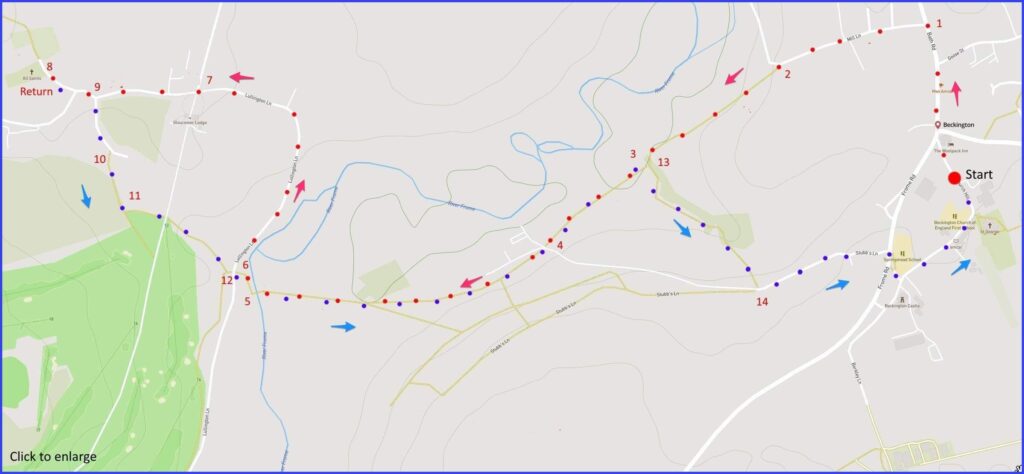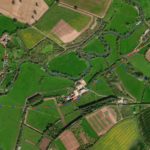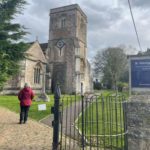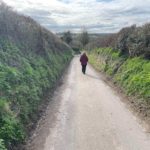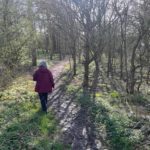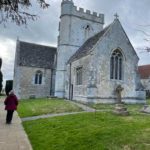A 4.5 mile easy walk around Beckington on the Somerset border. Many stiles, possible muddy paths. Click map to enlarge. Red dots outward. Blue dots return. Click here for an aerial view. Click here to download/print PDF. (There is a GPX route option here for phone/tablet download. But only follow this link after watching this GPX help video). Friendly warning: all files relating to walks are published here on good faith but on the understanding that users must be responsible for their own safety and wellbeing.
(Routes from map points + metres to next point)
Start: Parking possible in side streets. Walk to main road, uphill to leftward junction with Mill Lane [B] Walk forward on lane to junction at sharp bend. 230m
2: Veer leftwards up to a farm gate, walk along a hillside field towards stile leading into short fenced path [C] with further stile at end. 270m
3: Ignore “Loop” sign but walk forward to next stile and a wooded area. More stiles leading to farm and lane junction. 310m
4: Cross lane, walk alongside farm buildings. Continue straight but rightwards, passing a pill box on right until reaching River Frome [E] 400m
5: Cross River on bridge [F]. Walk diagonally to stile to lane. 70m
6: Head right up Lullington Lane following this until reaching crossing at Gloucester Lodge. 500m
7: Walk past this grand driveway leading to lodge on your left, following road to junction [G]. 200m
8: Follow Lullington Lane to right, round to the parish church [I]. 120m
8 (turnaround) Retrace (blue on map) steps until junction. 120m
9: Head down cul-de-sac slope at red phone box to join with fieldpath. 120m
10: Turn through ‘no fouling’ gate.
11: Walk past “please keep to the footpaths” and shortly walk beyond solitary post with two footpath arrows. Drop down left side to stile and lane.
12: Retrace steps until 13 and follow this path uphill until…
14: the (Stubbs) lane that leads down into the village
The pictures below are in the order things were seen on this walk. Clicking on any one will enlarge it (and the slideshow)
The walk
Agreed – this is not a “Wiltshirewalk”. But its close enough to the border to be “good walk for Wiltshire folk”. To Lullington and back again. With the substantial Orchardleigh estate in between. This is a mixture of lanes and field walking. Although all paths are official footpaths, some turns are not marked and so close attention to the map is advised. However, it’s a varied and rewarding journey.
Beckington
This was a medieval wool town, with fulling mills on the River Frome (some of which were burned down by rioting workers in 1766). Small cottages on Church Street and Goose Street reflect the spinning and weaving part of the industry. The place is “uncommonly rich in worthwhile stone houses” says Pevsner. While more substantial properties on Frome Road would be for the bosses. E.g. Beckington House and Beckington Abbey as you walk up to Mill Lane. How did towns like this cope after the 19th century when the west country wool trade was collapsing? There are no obvious clues to how it adjusted.
On more cerebral history – the Shakespeare-influencing Elizabethan poet, Samuel Daniel, lived here and is buried (memorial also) at the church. Of which Pevsner declares: “the most ambitious Norman tower of any Somerset parish church”
Orchardleigh estate
The pill box you pass on this walk seems to be part of the wartime “stop line” that ran from south of Bath to Salisbury and then the coast. After those paths you head up Lullington Lane to a road crossing (map 7, photo [G]) on the left part of which you will see the flamboyant Gloucester Lodge – a turreted piece spanning an apparent driveway (£400-600 per night, including outdoor hot tub). It is dated 1434 but, don’t be fooled, it was built in 1816. Where this driveway leads is to the substantial Orchardleigh Castle and estate. If you could wander in (which isn’t exactly encouraged) you would find a lake, a moted church, an 18-hole golf course and a private air strip.
Yes, it’s a weddings venue! The publicity says that only two families have dwelt on the estate since Norman times (excluding the current owner who purchased and revived it around 2002). The Champney family owned it first of all but by the 19th century they were overwhelmed with debts and so sold up to William Duckworth (descendants of which own the publishing company). In 1856 the original medieval castle was replaced by a Victorian ‘stately home’ – perhaps another building not the age it would prefer to be.
Lullington
This little village is also not quite what it seems. The Pump and Corner cottages are picture book ancient – but actually they were built in the 19th century. Yet it’s an attractive settlement and boasts a fine Norman church – “perhaps the most enjoyable Norman village church in Somerset” says Pevsner. While Simon Jenkins declares that the Norman font is “one of the finest in Somerset”. Yes, look at the font – one of the carved rings shows a fascinating circle of animals with foliage coming out of their mouths. But the real treasure is the Norman north door (walk round the outside to find it) with its richly decorated carving.
Beckington return
As you cross from Stubbs Lane onto the Frome Road, notice across to your right the strangely coloured Beckington Castle. It was built in the 17th century by one of the ubiquitous Wiltshire Long family – themselves made rich by the wool trade. Although it may have been superimposed on an earlier medieval building. It didn’t pick up the “castle” label until 1839. During its long life on this spot it has been variously a school, a hotel, an antiques showroom and a private house. A grey woman was once rumoured to haunt this building – thought to be an abbess.
You may also notice next to it Wool Hall (15 Castle Corner). !6th century but much altered and restored in 19th. In the 1980s it was converted into a recording studio by the band ‘Tears for Fears’ (one catchy hit). Later it become fully commercial and attracted the likes of The Smiths (‘Strangeways, here we come’ recorded at this studio). Although the most long running customer was Van Morrison, who bought the place (but sold it in 2002 for £1m) Since then it’s been a private home.
Finally, you might appreciate refreshment at The Woolpack – 16th century coaching inn rebuilt in the 18th. Plenty of room – although a few suspicious stares from locals taking afternoon beers.

